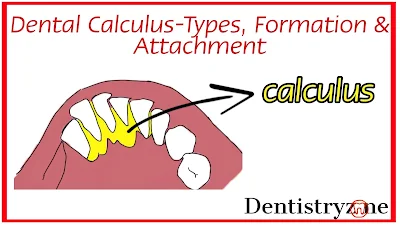Dental Calculus- Types, Formation & Attachment | Periodontology | Dentistry.
Dental Calculus- Types, Formation & Attachment | Periodontology | Dentistry.
What is Dental calculus?
Dental calculus is the hard deposit formed as the result of the mineralization of the dental plaque and is generally covered by a layer of unmineralised dental plaque. It is adherent, calcified or calcifying masses that form on the surfaces of teeth and dental prosthesis.
Composition of dental calculus
It is made up of both organic and inorganic components.
The inorganic component includes calcium, phosphorus, carbonate, sodium, magnesium fluoride. Crystal structure includes hydroxyapatite, magnesium whitlockite, octacalcium phosphate and brushite.
The organic component includes a mixture of protein-polysaccharide complex, desquamated epithelial cells leukocytes, protein, lipids carbohydrates.
Types of Dental calculus
Based upon the position in relation to the free marginal gingiva. They are classified into
I) Supragingival calculus
II) Subgingival calculus
Supragingival calculus
It is also known as salivary calculus. It is a tightly adherent calcified deposit formed on the surface of the clinical crown above the free gingival margin. It is formed from saliva. It is white or yellow. It is a hard and clay-like consistency. Supragingival calculus is easily removed from the tooth. It is most commonly found on the buccal surface of maxillary molars and lingual surfaces of anterior mandibular teeth. It exhibits the crystal forms of hydroxyapatite and octacalcium calcium phosphate.
Subgingival calculus
It is also known as serumal calculus. Because it believed to form from the gingival exudates. It lies below the crest of the gingiva. It is greenish-black or dark brown. It has hard and flint-like consistency. The sodium content of this calculus increases with the depth of the pockets. It exhibits hydroxyapatite and magnesium whitlockite crystal forms and less likely brushite.
Formation of calculus
Calculus is formed as a result of mineralization of dental plaque. It is formed by the mineralization of salt content in the dental plaque which starts between the 1st and 14th days of plaque formation. In the first two days, plaque is 50% mineralised and the rest 60% to 90% are mineralised in 12 days. Calcification starts in the inner surface of the plaque. Calculus formation continues till it reaches its maximum level in about 10 weeks and 6 months.
Modes of attachment of calculus
I) Attachment using an organic pellicle
II) Mechanical interlocking into the surface irregularities such as resorption lacunae and caries
III) Penetration of calculus bacteria in cementum
II) Mechanical interlocking into the surface irregularities such as resorption lacunae and caries
III) Penetration of calculus bacteria in cementum
IV) The close adaptation of calculus under surface depressions to the slopes of unaltered cementum surface.











COMMENTS